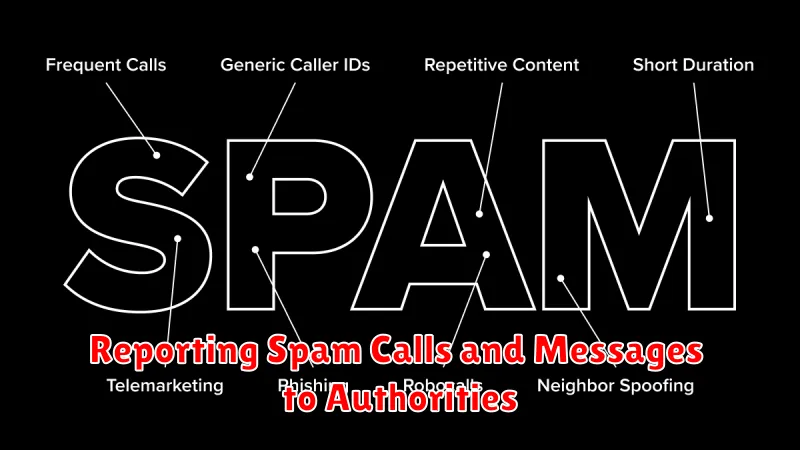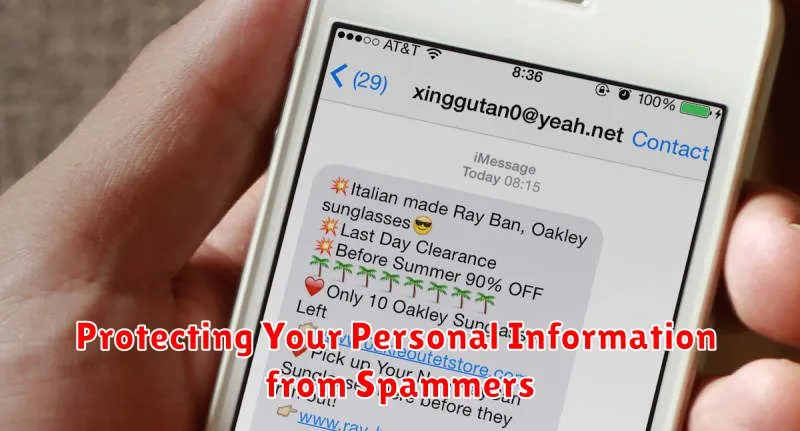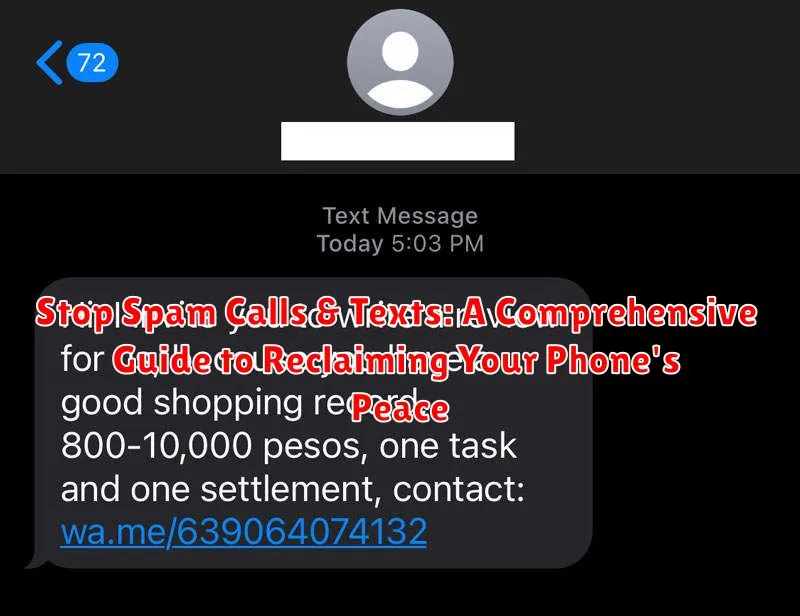Tired of incessant ringing and buzzing from spam calls and spam texts? Is your phone’s peace constantly shattered by unwanted solicitations, robocalls, and fraudulent messages? You’re not alone. Millions suffer from this digital intrusion, impacting productivity, increasing stress, and potentially compromising personal information. This comprehensive guide provides actionable strategies to effectively stop spam calls, block spam texts, and reclaim control over your mobile device. We’ll explore a range of solutions, from utilizing built-in phone features to exploring third-party apps, ensuring you can finally enjoy uninterrupted peace of mind.
This guide will delve into the nuances of identifying spam calls and spam texts, understanding the tactics employed by spammers, and implementing proactive measures to protect yourself. Learn how to effectively utilize call blocking features, report spam numbers, and filter unwanted messages. We will explore the efficacy of different approaches, including the National Do Not Call Registry, carrier-level blocking options, and specialized spam blocking apps. Whether you’re battling relentless robocalls, phishing attempts via text, or simply seeking tranquility, this guide offers the knowledge and tools to stop spam calls and texts and restore peace to your digital life.
Understanding the Different Types of Spam Calls and Messages
Recognizing the various types of spam can help you better understand the risks and take appropriate action. Here’s a breakdown of common spam calls and messages:
Robocalls
These are automated calls that often use pre-recorded messages. They may promote fake services, attempt to collect personal information, or try to sell unwanted products. Robocalls are often illegal if they are unsolicited and for commercial purposes.
Spam Texts (SMS)
Similar to robocalls, spam texts are unsolicited messages sent in bulk. They can contain phishing links, promote scams, or advertise unwanted services. Be wary of any text message from an unknown number, especially if it includes a link or requests personal information.
Telemarketing Calls
While not always malicious, unsolicited telemarketing calls can be disruptive. These calls aim to sell products or services. Understanding the difference between legitimate telemarketing and scams is crucial.
Phishing Calls and Texts
These are perhaps the most dangerous type of spam. Phishing attempts seek to steal your sensitive information like passwords, credit card numbers, and Social Security numbers. They often masquerade as legitimate organizations to gain your trust. Never provide personal information over the phone or via text unless you initiated the contact and are certain of the recipient’s identity.
Using Built-in Phone Features to Block Spam
Modern smartphones offer a variety of built-in features to help combat spam calls and texts. These tools can be a first line of defense against unwanted communications, offering a convenient and often free way to manage nuisance calls.
Most phones allow you to block individual numbers. After receiving a spam call or text, you can typically find an option in your recent call or message log to block that specific number. This prevents future calls and texts from that number from reaching you.
Some devices also offer a “Silence Unknown Callers” feature. Enabling this setting will silence calls from numbers not saved in your contacts, sending them directly to voicemail. This can be useful for screening out unknown spammers, but be mindful that you may miss calls from legitimate but unsaved numbers.
Caller ID and spam identification features are also becoming increasingly common. Your phone might be able to flag suspected spam calls, alerting you with a warning label before you answer. The effectiveness of these features can vary, but they can provide helpful context and allow you to make informed decisions about whether to answer a call.
Exploring Third-Party Spam Blocking Apps
Beyond your phone’s built-in features, a wealth of third-party apps offer advanced spam call and text blocking. These apps often leverage larger databases of known spam numbers and utilize more sophisticated algorithms to identify and filter unwanted communications.
Many reputable spam blocking apps are available for both Android and iOS devices. When choosing an app, consider features such as:
- Automatic spam identification and blocking: The app should proactively block known spam numbers without user intervention.
- Spam number lookup: Reverse lookup functionality helps identify unknown callers and texters.
- Customizable block lists: Allow you to add specific numbers to your personal block list.
- Call reporting and community feedback: Contribute to a larger database by reporting spam calls and benefit from the experiences of other users.
Research different apps and compare their features, user reviews, and pricing structures (some apps are free, while others offer premium subscriptions) to determine the best fit for your needs. Carefully review the app’s permissions before installation to ensure it respects your privacy.
Registering Your Number on the National Do Not Call Registry
A crucial step in minimizing unwanted calls is registering your phone number with the National Do Not Call Registry. This free service allows you to register both landline and mobile numbers. While it won’t eliminate all spam calls (as it primarily targets telemarketers), it can significantly reduce the volume of legitimate sales calls you receive.
Registration is straightforward and can be completed online or by phone. Be aware that it can take up to 31 days for the registry to take full effect. It’s important to understand that registration doesn’t expire. Once registered, your number remains on the list until you remove it, disconnect the number, or it’s reassigned.
Keep in mind that registering your number will not stop calls from political organizations, charities, debt collectors, or companies you’ve recently done business with. This registry focuses specifically on reducing sales calls from telemarketers.
Reporting Spam Calls and Messages to Authorities

Reporting spam calls and texts helps authorities track trends and take action against illegal robocallers and scammers. While it might not stop the calls immediately, it contributes to the larger effort of combating unwanted communications.
In the United States, you should report unwanted calls and texts to the Federal Communications Commission (FCC). You can file a complaint online through their website. Provide as much information as possible, including the phone number, date, and time of the call or text, and the content of the message if applicable.
You can also report spam texts to your wireless carrier by forwarding the message to 7726 (SPAM). This helps your carrier identify and block spam messages from reaching their network.
For suspected fraud or identity theft related to spam calls or texts, report the incident to the Federal Trade Commission (FTC). They maintain a database of consumer complaints that assists law enforcement in identifying and prosecuting perpetrators.
Advanced Techniques for Identifying and Blocking Spam
Beyond basic blocking, several advanced techniques can significantly reduce spam calls and texts. Reverse number lookup services can help identify unknown callers and reveal if the number is associated with known spam operations. These services often compile user reports and ratings, providing valuable insights into a number’s legitimacy.
Third-party spam blocking apps offer more comprehensive filtering capabilities. These apps typically maintain extensive databases of known spam numbers and utilize sophisticated algorithms to identify and block suspicious calls and texts. Many offer features like automatic call blocking, spam identification, and even the ability to report spam numbers directly from the app. Be sure to research and choose reputable apps to ensure data privacy.
Analyzing call patterns can also help identify potential spam. Frequent calls from unknown numbers with similar prefixes or area codes, especially if they hang up after one or two rings, can indicate robocalling activity. Noting these patterns and reporting them to your carrier can assist in their spam identification and blocking efforts.
Protecting Your Personal Information from Spammers

Protecting your personal information is crucial in the fight against spam. Spammers often seek to collect data for malicious purposes, including identity theft and fraud. By taking proactive steps, you can minimize your risk.
Be cautious about sharing information online. Avoid posting sensitive details like your full name, address, phone number, and email address on public forums or unsecured websites. Think twice before filling out online forms or surveys that request unnecessary personal data.
Review privacy settings on social media platforms. Limit the visibility of your personal information to trusted connections. Be mindful of the information you share in posts and comments.
Use strong and unique passwords for your online accounts. Enable two-factor authentication whenever possible for an added layer of security.
Regularly monitor your accounts for any suspicious activity. Check your credit reports periodically for unauthorized inquiries or accounts.

